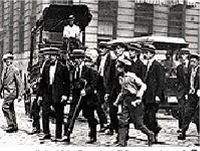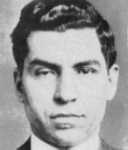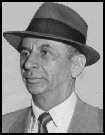
Immigrants Hall of Fame

Immigrants Hall of Fame
Hall of Shame
[ Ponzi ] [ Luciano ] [ Lansky ]
|
Carlo
Ponzi Italian immigrant who left home in 1903 at the age of 20 for America. He thereupon participated in scams everywhere from Providence, Rhode Island, to Montreal, Canada -- where his restless, scheming brain landed him in prison for a short time.
Carlo “Charles” Ponzi was born in
Parma, Italy 1882 and then emigrated to the United States in November of
1903. Over the next fourteen years, Ponzi wandered from city to city and
from job to job. He worked as a dishwasher, waiter, store clerk, and even as
an Italian interpreter. In 1917, he settled back into Boston where he took a
job typing and answering foreign mail. It was here in Boston on that fateful
day in August of 1919 that Ponzi discovered the mechanism to make both him
and his investors very wealthy. Ponzi set up an office at 27 School Street in Boston, creating a firm called the Securities and Exchange Company. His offer to the public was simple. Investors who bought into the company would get a 50 percent return on their money in 45 days; a 100 per cent return in 90 days. Since banks at the time were paying five percent interest annually, Ponzi's sales pitch aroused interest. Thence, sales of stock in his company percolated. Carlo -- or Charles as he preferred to be called in his adopted land -- had a gift for gab and the ability to tell people what they wanted to hear. If people actually wanted to get their money back in 45 days, Ponzi was happy to oblige. He had plenty of money on hand at first. In fact, most people chose to reinvest for another 45 days, hoping for an even bigger score. His scheme depended on impeccable timing: as long as Ponzi attracted new investors in growing numbers, he could use their cash to pay off the interest on the earlier investors. Ponzi started selling in December of 1919. By the spring, he was rich. He bought fancy suits and took to carrying a cane and a gold-tipped cigarette holder. He bought an expensive car and hired a chauffer. He brought his mother over from Italy. He purchased a huge house in Lexington for his wife Rose. The Ponzi scheme, as it later would become known in his honor, initially netted Ponzi more money than he could spend. In May 1920, he took in $442,000. By the summer, he was taking in $250,000 a day. Ponzi would stuff money into closets and desk drawers just to keep things neat in his office. His rapid rise to wealth aroused the interest of newspapers who wanted to know more about the man with the Midas touch. The publicity attracted new investors, but it also caught the attention of law enforcement. In the meantime, Ponzi had been robbing Peter to pay Paul, as he knew better than anyone else, Ponzi's scheme started well but was bound to end badly. The mounting pressure from investors, reporters, law enforcement agents drove Ponzi to surrender to the police. Ponzi was asked by the flocking reporters whether he wanted to make a statement. "The public deserves it, don't you think?" one reporter said. "The public deserves exactly what it gets," Ponzi said. "No more, no less." Charles Ponzi spend more than a decade in prison. The man who had fleeced Bostonians out of millions was abandoned by this friends and divorced. He died in a charity ward of a Brazilian hospital in 1949. The last photograph of Ponzi, taken at the hospital, shows with a big smile on his face. |
 Carlo's the one with the cane. |
|
Lucky
Luciano Charles "Lucky" Luciano was born in 1897 in Lercardia Friddi, Sicily. The luckiest thing that ever happened to him was immigrating to New York City. In his teens, Luciano became adept at various vices, most notably narcotics. At age eighteen he was convicted of peddling heroin and morphine and was committed to a reformatory for six months. Upon his release he resumed narcotics dealing. By 1916, Luciano was a leading member of the notorious Five Points Gang and named by police as the prime suspect in a number of murders. By 1920, Luciano was a power in bootlegging rackets (in cooperation with Lansky and his erstwhile partner Benjamin "Bugsy Siegel). Luciano had become the most powerful member of the New York Mafia. A dandy dresser, Luciano often frequented well-known nightclubs on Broadway. He looked menacing, thanks to a famous scarring he received in 1929, when knife-wielding kidnappers severed the muscles in his right cheek, leaving him with an evil droop in his right eye. Contrary to popular belief, he didn’t get the nickname "Lucky" for this incident, but instead got it for being a whiz at selecting winning horses at various tracks. Well ...Luciano was deported back to Italy before World War II and died in Italy. |
 Broadway nightclub devotee and chief executive officer of the Mob.. |
|
Meyer
Lansky
An agent of the FBI
would say of him with grudging admiration: "He would have been chairman of the board of General Motors if he’d gone
into legitimate business." Luciano once explained, "I learned a long time before that Meyer Lansky understood the Italian brain almost better than I did…I used to tell Meyer that he may’ve had a Jewish mother, but someplace he must’ve been wet-nursed by a Sicilian." Luciano often said Lansky "could look around corners," or anticipate what would happen next in underworld intrigues, and that "the barrel of his gun was curved," meaning he knew how to keep himself out of the line of fire. Through the years that was Lansky’s way. It was Lansky who opened up what was for a time the Syndicate’s greatest source of income, gambling in Havana. He personally handled negotiations with the dictator Batista. Luciano was pleased with this money machine and never stepped on the toes of Meyer Lansky and listened to him intently. It was Meyer who had the brains of the outfit, but it was Luciano's gang that provided the muscle. Lansky was deported from the
United States, denied permission to live in Israel, and died in South
America.. |
 Chief financial officer of the Mob |